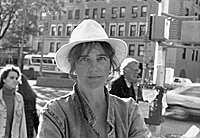“ I remember the explosive laughter, the deep silences, the stunned attention as the final shot seemed to continue forever, and then the ovation. We’d had a revelation. This was the direction American movies should take: Into idiosyncratic characters, into dialogue with an ear for the vulgar and the literate, into a plot free to surprise us about the characters, into an existential ending not required to be happy. ‘Five Easy Pieces’ was a fusion of the personal cinema of John Cassavetes and the new indie movement that was tentatively emerging. It was, you could say, the first Sundance film.” – Roger Ebert, on the powerful effect of the movie debut, from New York State Writers Institute website
Five Easy Pieces’ famed Chicken Salad Sandwich scene was shot in a Denny’s Restaurant in Eugene, Oregon.

The Far Corner hereby claims Five Easy Pieces as an Oregon film on the basis of a) the Oregon location shooting and b) the casting of Portland born and raised Sally Struthers.



1 response so far ↓
1 Robert Andropolis // May 1, 2011 at 7:09 pm
This film is largely responsible for my attending the London Film School. As Roger Ebert says above so eloquently, “Five Easy Pieces” was a revelation. In “Bob Rafelson,” (a Twayne’s Filmmakers Series Book), author Jay Boyer reveals interesting production insights. Rafelson allegedly got the idea for the film when he envisioned Jack Nicholson in the back of an open-bed truck, playing the piano as it drove away (the still image above on this site.) He turned the script writing over to Carol Eastman, a friend of Nicholson’s. her ending as written shows Bobby DuPea’s (Nicholson’s) ending, with him driving his Mercury off a bridge. Rafelson, never one to be bound by the script, at the last minute changed this dark denouement into the stunning minimalist masterstroke as described above by Ebert.
The famous confessional scene on the heath with Bobby and his father brought forth a dispute between Nicholson, Eastman and Rafelson. Boyer: “It is a pivotal scene in the film, one that offered Bobby a chance to reveal himself more fully than any scene to that point. Nicholson reportedly crossed out what had been written for him to say, penciling “Something else?” in the margins. Rafelson wanted Bobby to look deep within himself, to sob to the point of interrupting his speech, and finally to break down in tears. Nicholson thought that was out of character. So, too, did he doubt that Bobby would be as introspective as Eastman’s script seemed to envision. As the morning came to shoot the scene, Nicholson arrived on the heath where the crew members were setting up the cameras. He drew upon his experience as a screenwriter, keeping the monologue to the fewest number of lines he could. He had apparently made up his mind to resist crying on cue, as Rafelson wanted, preferring instead to let the monologue take him emotionally to whatever depths it could. As written, the monologue had personal significance for Nicholson, articulating the pains of failure as it did, and Nicholson has proclaimed the speech a “breakthrough” for himself as an actor. Once he began, he has said, he found a level of emotion that he had never before been able to bring to a part, and the tears flowed naturally. The scene was shot in one take.”
I recall Nicholson also saying that of all his roles, he most identifies with that of Bobby DuPea’s. The late Carol Eastman was a friend of his from having previously worked together on Roger Corman productions
Leave a Comment